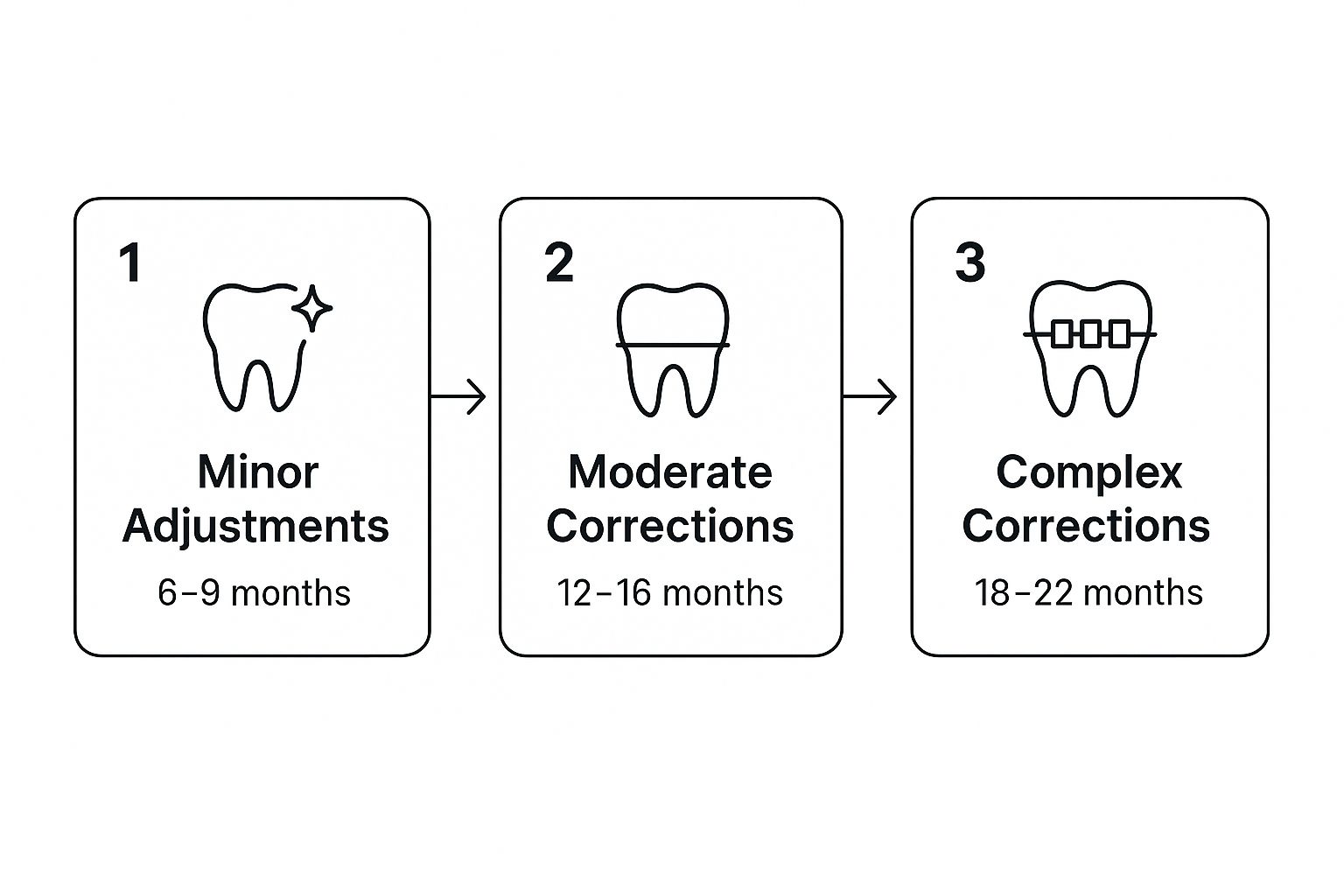How Long Does Invisalign Take? Find Your Treatment Timeline
- Caterina Rutter
- Oct 15
- 11 min read
If you're asking, "how long does Invisalign take?", you're really asking about your specific smile. While every case is unique, a good rule of thumb is that most people finish their treatment in about 6 to 22 months.
This range covers everything from minor tweaks to more significant adjustments, giving you a realistic idea of what to expect on your path to a straighter smile.
Your Invisalign Treatment Timeline Explained
Think of your Invisalign journey like a road trip. The complexity of your case determines the distance, but the most important factor you control is how consistently you "drive"—or in this case, wear your aligners.
To keep your treatment on schedule, you must wear your aligners for the recommended 20-22 hours every single day. This isn't just a suggestion; it's the engine that powers your treatment forward, ensuring your teeth move exactly as your orthodontist has mapped out.
Typical Timelines By Case Complexity
So, what determines if your treatment is a short sprint or a longer journey? It all comes down to the complexity of your case. We can generally break down treatment plans into a few common categories based on the amount of correction needed.
This chart gives you a quick visual of how long different types of cases usually take.

As you can see, a simple case of minor crowding might wrap up in just a few months, whereas a more involved bite issue will require a longer commitment to get those perfect results.
To give you a clearer picture, here’s a quick breakdown of what to expect based on how much work your smile needs.
Invisalign Treatment Timelines by Case Complexity
Case Complexity | Typical Treatment Duration | Common Issues Addressed |
|---|---|---|
Mild | 6 - 12 Months | Minor crowding, small gaps, slight relapse from braces |
Moderate | 12 - 18 Months | More noticeable crowding, spacing issues, minor bite problems |
Complex | 18 - 22+ Months | Significant overbites, underbites, crossbites, severe crowding |
This table helps illustrate why there's no single answer to the timeline question. Your individual needs will always determine the length of your treatment.
Actionable Insight: Your treatment time is a direct reflection of your orthodontic needs and your daily discipline. A minor spacing issue will resolve much faster than a significant overbite correction, but consistent wear is what keeps either case on track.
For a really detailed breakdown of what goes into the timeline, you can check out a full UK treatment timeline guide for clear aligners. Of course, the only way to get a precise estimate for your smile is to come in for a professional consultation. You can learn more about getting started with orthodontics in Tempe and take that first step.
Breaking Down Your Invisalign Journey: A Stage-by-Stage Guide

Understanding "how long does Invisalign take?" is easier when you see it as a series of clear, predictable stages. Each step is designed to move you closer to your final destination—a perfectly aligned smile.
It all starts with creating your personalized treatment map.
Stage 1: The Initial Consultation and 3D Scan
Your journey begins with an initial consultation where you and your dentist discuss your smile goals. If you both agree Invisalign is the right choice, the next step is a high-tech 3D digital scan of your teeth. This scan creates a precise model of your mouth, allowing your dentist to map out your entire treatment and even show you a preview of your final smile. You can learn more about the role of a modern dental X-ray in Tempe in detailed planning.
Actionable Insight: The 3D scan is the architectural blueprint for your new smile. It eliminates guesswork and allows for a predictable, customized treatment. Use this consultation to ask specific questions about your projected timeline and see the end goal before you even start.
Once your digital plan is finalized and approved, your custom aligners go into production. This typically takes about 2 to 4 weeks, after which your first set of trays will be ready.
Stage 2: Active Treatment and Watching the Changes Happen
This is the main phase of your journey. You'll receive your first sets of aligners, and your dentist will show you exactly how to wear and care for them. Most patients switch to a new set of aligners every 1 to 2 weeks.
This active phase is where the transformation happens. According to clinical data, the average treatment time for adults is between 12 to 18 months. You'll likely notice small shifts within the first 2 to 4 weeks, and friends and family may see a visible difference within 2 to 3 months.
Stage 3: The Refinement and Retention Phases
As you near the end of your initial aligner series, your dentist will assess your progress. Sometimes, a few teeth need an extra push to get into their perfect spot. This is the refinement phase, which may involve a few additional aligners to fine-tune your results.
After your active treatment is complete, you'll enter the most critical stage for long-term success: retention. To prevent your teeth from shifting back, you'll receive a retainer. Consistent wear, especially in the beginning, is essential for making sure your new smile lasts a lifetime.
What Affects Your Invisalign Treatment Time?

It's a common question: "My friend finished Invisalign in eight months, so why is my treatment over a year?" The answer is that no two smiles are the same. Your treatment plan is tailored to your unique starting point and goals.
Understanding the key factors that shape your timeline gives you a clearer picture of what to expect and which parts of the process you can directly control.
The Complexity of Your Case
The biggest driver of your timeline is the complexity of your orthodontic needs. A simple case, like closing a small gap, is a short journey. Correcting a severe overbite is more like a marathon—it takes longer to reach the finish line.
More complex issues require more sets of aligners to guide your teeth into their final positions. Reasons for a longer treatment include:
Severe Crowding: Teeth need to be moved gently and methodically to create space.
Large Gaps: Closing significant spaces is a gradual process that requires consistent force over many months.
Bite Correction: Fixing an overbite, underbite, or crossbite involves moving entire sections of teeth, which naturally extends the timeline.
Tooth Rotation: A significantly twisted tooth needs more time to be carefully turned into the correct orientation.
Each of these situations requires a carefully choreographed series of movements, with each new aligner building on the work of the last.
Your Commitment to the Plan
While your dental needs set the initial baseline, your daily habits can be the accelerator—or the brake—on your treatment. Invisalign aligners only work when they are in your mouth applying steady pressure.
Actionable Insight: The most crucial element you control is wear time. Not hitting the recommended 20-22 hours per day is the single fastest way to fall behind schedule. Set timers when you eat and build a routine of putting aligners back in immediately after brushing.
Missing wear time can cause a chain reaction where your next aligners don't fit correctly, forcing you to backtrack and potentially adding weeks or months to your treatment.
Age, Biology, and Your Orthodontist’s Strategy
Your body's biology also plays a role. Teenagers often have more malleable bone tissue, allowing teeth to shift more quickly. Adults can achieve excellent results, but their denser bone structure may mean the process is slightly slower.
Your orthodontist's strategy is also key. They may use tools like SmartForce® attachments—tiny, tooth-colored bumps bonded to certain teeth. These give the aligners extra grip to perform more complex and efficient movements.
Globally, Invisalign has been used to treat over 8 million patients, with a satisfaction rate around 96%. Real-world case studies show average treatment times often land between 11 and 16 months, depending on the specific issues being corrected. You can learn more about what Invisalign treats to see how different conditions impact the process.
Your Invisalign journey is a partnership. While some factors are set, others depend entirely on your diligence. This table breaks down how you can actively contribute to keeping your treatment on schedule.
How Different Factors Affect Your Invisalign Timeline
Factor | How It Can Speed Up Treatment | How It Can Slow Down Treatment |
|---|---|---|
Case Complexity | Minor crowding or small gaps that require fewer, simpler movements. | Severe bite issues, major rotations, or large gaps that need more intricate steps. |
Patient Compliance | Consistently wearing aligners for 20-22 hours every single day. | Frequently removing aligners, forgetting to put them back in, or losing them. |
Age | Younger patients (teens) may experience faster tooth movement due to more pliable bone. | Adults may have denser bone, which can sometimes lead to a more gradual rate of movement. |
Oral Hygiene | Keeping teeth and gums healthy prevents delays caused by cavities or gum disease. | Poor hygiene can lead to treatment pauses for necessary dental work. |
Treatment Plan | A straightforward plan using standard aligner protocols. | A plan requiring SmartForce® attachments, rubber bands, or other auxiliaries for complex movements. |
Check-up Adherence | Attending all scheduled appointments allows for timely adjustments and progress monitoring. | Missing appointments means we can't provide your next set of aligners or check if you're on track. |
Ultimately, the best way to keep your treatment on the fast track is to follow your orthodontist's instructions to the letter. Wear your aligners, keep them clean, and show up for your check-ins—your future smile will thank you for it.
Comparing Timelines for Different Dental Issues
The question "how long does Invisalign take?" is best answered with real-world examples. Seeing how treatment plays out for specific dental issues gives you a much clearer picture than general timelines alone.
Let's walk through a few common scenarios.
Scenario 1: Minor Spacing
Imagine a patient with small but noticeable gaps between their upper front teeth. This is a straightforward fix where the teeth have a clear path to move without complex bite adjustments.
For a case like this, the treatment is typically quick and efficient. The aligners are programmed to gently guide the teeth together over a relatively short period.
A typical plan for minor spacing or very slight crowding often wraps up in as little as 6 to 9 months. It’s an excellent option for a cosmetic touch-up without a long-term commitment.
Scenario 2: Moderate Crowding
Now consider a more common issue: moderate crowding. This occurs when there isn't enough room in the jaw, causing teeth to overlap or twist. The treatment plan is more strategic, often starting by expanding the dental arch or shifting molars to create space before aligning the front teeth.
This multi-stage process naturally takes longer, usually landing in the 12 to 16 month range.
Scenario 3: Complex Bite Correction
Finally, we have cases that involve fixing the bite itself, like a significant overbite or crossbite. Here, the goal is to fundamentally change how the upper and lower jaws fit together.
These corrections almost always require SmartForce® attachments, which are tiny, tooth-colored bumps bonded to specific teeth. They give the aligners the extra grip needed to execute more difficult movements. Because this process re-engineers the smile's foundation, you can expect treatment to last anywhere from 18 to 22 months. The results, however, improve both the look and function of your smile.
While Invisalign is incredibly capable, some severe alignment issues might need a different approach. For patients who aren't ideal candidates but still want to fix cosmetic imperfections, learning about dental veneers in Tempe can open up another great path to a beautiful smile.
Actionable Tips to Keep Your Invisalign Treatment on Track

While your orthodontist designs the roadmap, you are in the driver's seat. Your daily habits are the single biggest factor in determining how long your Invisalign treatment takes. Here’s how you can make sure your journey is as smooth and efficient as possible.
Master Your Daily Wear Time
The 20 to 22-hour daily wear time is the non-negotiable golden rule of Invisalign. Failing to meet this target is the most common reason treatments fall behind.
Here are a few practical tips to stay on track:
Use a Timer: Every time you take your aligners out to eat, set a timer on your phone as a reminder to put them back in promptly.
Create a Routine: Make putting your aligners back in the final step of your post-meal routine, right after brushing.
Try a Tracking App: Use an app designed for Invisalign to log your wear time and turn it into an achievable daily goal.
Consistency is key. Every hour your aligners are in is an hour you are actively moving closer to your goal.
Keep Your Aligners and Your Mouth Spotless
Excellent hygiene prevents delays. If a dental issue like gum inflammation or a cavity develops, you may have to pause your treatment. Keeping aligners clean is also crucial, as dirty trays can trap bacteria against your teeth.
Actionable Tip: Rinse your aligners every time you remove them. Gently brush them daily with a soft toothbrush and clear, unscented soap to prevent buildup and keep your mouth healthy.
Use Your Aligner "Chewies"
Those small foam cylinders called "chewies" are more important than they look. Biting down on them for a few minutes each day, especially with a new set of trays, helps seat the aligner perfectly over your teeth. This eliminates air gaps and ensures the aligner applies the precise pressure needed to guide your teeth effectively.
Don't Skip Your Check-Ups
Your regular check-ups are critical progress reports. During these visits, your orthodontist confirms your teeth are "tracking," or moving as predicted. Missing an appointment can halt your progress, as you can't get your next set of aligners or have your orthodontist address small issues before they become delays. These visits are essential for keeping you on the fast track.
Life After Invisalign: What to Expect
You've finished your last set of aligners—a huge accomplishment! But your journey to a permanently straight smile has one more crucial chapter: the retention phase.
Think of active treatment as building a new house; retention is the maintenance that keeps it standing strong for years.
Safeguarding Your Smile with Retainers
Teeth have a "memory" and will try to drift back to their old positions. A retainer holds them in their new, perfect alignment. This step isn't optional; it's the only way to protect your investment and lock in your results.
Actionable Insight: Wear your retainer exactly as instructed by your orthodontist. This is a lifelong commitment. Initially, you'll likely wear it full-time, eventually switching to nights only. This small daily habit guarantees your smile stays straight for decades.
The real answer to "how long does Invisalign take?" must include this vital, final step.
Ready to start your own journey? Schedule a consultation today.
Common Questions About Invisalign Timelines
Even with a clear plan, questions will come up. Here are answers to some of the most common ones to help you feel confident throughout your treatment.
Can I Speed Up My Invisalign by Changing Aligners Early?
The answer is a firm no. Never change your aligners ahead of schedule. Each tray is designed to apply a specific, gentle force over a set period to move your teeth safely.
Rushing the process can damage your tooth roots and disrupt the planned sequence of movements, potentially extending your total treatment time. Trust the schedule your orthodontist provides.
Actionable Insight: Think of it like a timed recipe. Adding ingredients too soon disrupts the process. Your teeth need the full time with each aligner to move correctly and allow the surrounding bone to adapt.
What Happens if I Lose an Aligner?
Don't panic—it happens. Contact your orthodontist immediately. Do not decide on your own to skip to the next tray.
Your orthodontist will give you specific instructions based on where you are in your cycle. They might have you:
Go back to your previous aligner to prevent teeth from shifting back.
Move on to the next set if you were very close to your scheduled switch time.
Acting fast and following professional advice will prevent a small hiccup from causing a major delay.
Is Invisalign Faster Than Traditional Braces?
For many patients, yes. Invisalign often treats mild to moderate issues faster than traditional braces. A typical braces treatment can take 18 to 24 months, while many Invisalign cases conclude in 12 to 18 months.
However, for very complex bite corrections, traditional braces may still be the most efficient option. Your orthodontist will always recommend the treatment that will deliver the best, healthiest result for your specific needs.
Your journey to a new smile is one-of-a-kind, and getting clear, honest answers is the first step. At Beautiful Dentistry, we're here to explain everything and create a personalized plan that actually fits into your life.
Ready to find out exactly how long your Invisalign treatment will take? Book your $59 new patient exam and X-rays today!
Article created using [Outrank](https://outrank.so)



Comments